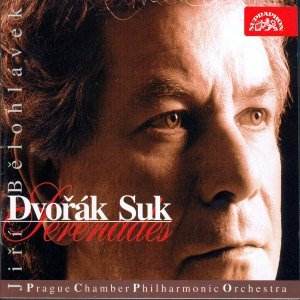|
|
Search MusicWeb Here |
|
 |
||
|
Founder:
Len Mullenger (1942-2025) Editor
in Chief:John Quinn
|
|
|
Search MusicWeb Here |
|
 |
||
|
Founder:
Len Mullenger (1942-2025) Editor
in Chief:John Quinn
|
 |
Antonín
DVORÁK (1841-1904) Serenade for String Orchestra Op. 22 (1875) Josef SUK (1874-1935) Serenade for String Orchestra in E flat major Op. 6 (1892) Prague Chamber Philharmonic Orchestra Recorded in the Domovina Studio, Prague, 1996 DDD Stereo |
| CD available for post-free online mail-order or you may download individual tracks. For some labels you can download the entire CD with a single click and make HUGE savings. The price you see is the price you pay! The full booklet notes are available on-line. | |
|
NOTE • Click on the button and you can buy the disc or read the booklet details • You can also access each track which you may then sample or down load. • Further Information. |
|
|
A really lovely disc that tempts one, if not to run out of superlatives, at least to indulge the metaphors! The infectious rhythmic spring of the lower strings at the start of Dvořák’s Serenade and the similarly enticing lift that the conductor imparts to the second movement waltz should put a smile on your face. Jirí Belohlávek seems concerned throughout with making the bass line clear and well articulated such that I was often drawn to the goings-on from the right-hand side of the sound field. Articulation is a strong point from everyone else too. The violins negotiate the awkward corners of this music and dispatch them with an easy virtuosity that is a joy to hear. It is all so very musical. The larghetto is unexpectedly slow, making it still more beautiful than usual and this tempo lends the allegro vivace finale a still greater contrast as Behlohávek shoots off at high speed without once losing sight of the dance rhythms.
Dvořák was Suk’s teacher and, according to the informative note, he sent Suk off on holiday in 1892 with the advice to go and write something cheerful. For me this serenade has an unintentional humour as one listens to poor Suk desperately trying to deny his melancholic nature and be just that, cheerful. Whatever he does to lighten the heart he soon sinks back into pathos, proving that he was constitutionally incapable of being happy! The opening tune of Suk’s serenade yearns like mad. The second movement is marked allegro ma non troppo and is utterly beautiful but Suk soon slows down to linger and yearn a bit more. So it goes on, the adagio is home ground of course - and includes some hushed playing of a quality one rarely gets on disc - an absolutely wonderful creation. Having reached his finale with his teacher’s injunction ringing in his ears Suk launches into an allegro giocoso that is almost light-hearted for a good two minutes, then he goes all solemn again. The cheerful ending did not convince me for one moment.
The recording is clear but perhaps at times a touch crowded. The sound is definitely not the lovely acoustic of the House of Artists that the Czech Philharmonic have often used for recordings. This is the Domovina Studio, Prague, and it sounds like any other studio, a sort of "not there" quality that leaves the orchestra without the acoustic space that lends reality. But this does not detract from a top class wallow! A final question, why did it take nearly six years for this disc to reach us since everything about the production has 1996 attached to it?
Dave Billinge
|
| ADDITIONAL INFORMATION •
You can sample only 30 seconds (or 15% if that is longer) of a given track. Select from the View tracks list. Each sample will normally start from the beginning but you can drag the slider to any position before pressing play. • PLEASE NOTE: If you are behind a firewall and the sound is prematurely terminated you may need to register Ludwig as a trusted source with your firewall software.
•You will need Quicktime to hear sound samples. Get a free Quicktime download here • If you cannot see the "Sample All Tracks" button you need to download Flash from here.
|
|
|
Return to Index |